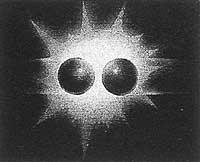Any new particle?
1994/06/01 Elhuyar Zientzia Iturria: Elhuyar aldizkaria
This year researchers at the Argonne National Laboratory in Illinois will have to solve an enigma that has been unsolved for ten years. The problem refers to heavy ion shock. For example, collisions of uranium ions in large energies lead to a superratio of about 200 protons and about 300 neutrons. This huge atom lasts only a fraction of a second, but is enough to create incredible electric and magnetic fields.
One of the consequences of these high-intensity zones is the vacuum formation of pairs of electrons and their antiparticles (positron). This is a shocking phenomenon, since it consists of the detection of particles and antiparts that only exist in the vacuum as possibilities.
This phenomenon was first detected in the German Darmstadt in 1983. The generation of electrons and positrons was still inexplicable, but the distribution of energy by emitted electrons and positrons had a peak. For physicists this peak is explained by the formation of a particle and its subsequent disintegration as electrons/positrons. This particle, in any case, would be of small mass, three or four times greater than that of the electron (much less than the proton or neutral). But these types of particles have not been detected in their trials.
In order to solve the mystery, the researchers of the Argonne laboratory have prepared a detector to analyze the pairs of electrons/positrons generated by the shock of heavy ions. This is an apparatus that began working in 1993 and that this year should be resolved before the end of the year. If you check for a new particle, it will be a first-order discovery. And we do not know anything of origin and behavior.
Another hypothesis is that there would be no new particles, but a state associated with the electron and positron called positronium. However, it is not clear how and why.
The third hypothesis is based not on the new elementary particle, but on a high intensity electromagnetic field and a specific vacuum state.

Gai honi buruzko eduki gehiago
Elhuyarrek garatutako teknologia




